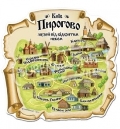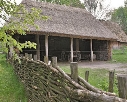Урок англійської мови у середній школі, "Рукотворні чудеса" "Man-made Wonders", A2
План-конспект уроку на основі навчальних матеріалів з підручника "Click On 2" Express Publishing. Містить вправи та діяльності для розвитку усіх мовленнєвих компетентностей.
GRADE 7
MAN-MADE WONDERS
The aims of the lesson: activating the topic vocabulary “Buildings, structures and materials”; practising the Passive Voice (Present and Past Simple); developing the skills of listening, reading and speaking, asking and answering the questions on the topic; enriching students` knowledge and broadening their world outlook; developing the skills of cooperative pair, group and team work.
- WARMING-UP
Hello, children! How are you? I see you are all in a good mood! So, I think, we are going to enjoy our virtual travelling around the world and visiting the most beautiful buildings! By the way, can you guess the names of these beautiful places?
Match the pictures to the names of the famous landmarks!
 The Eiffel Tower
The Eiffel Tower
 The Petronas Twin Towers
The Petronas Twin Towers
 The Tower of London
The Tower of London
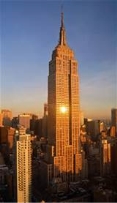 The Empire State Building
The Empire State Building
 The Pompidou Centre
The Pompidou Centre
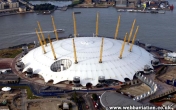 The Millennium Dome
The Millennium Dome
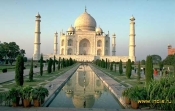 The Taj Mahal
The Taj Mahal
 The Colloseum
The Colloseum
 Sidney Opera House
Sidney Opera House
- VOCABULARY AND GRAMMAR
Look at the landmarks! Which is made of concrete, marble, stone, glass, steel, bricks, iron?
Look at the table and make true sentences about each landmark!
Sidney Opera House in Australia
The Tower of London was/were built stone
The Colloseum is made of marble
The Empire State Building was completed to celebrate the new millennium
The Taj Mahal by Gustav Eiffel
The Eiffel Tower is/are located in 1931
The Petronas Towers was designed in Rome
The Millennium Dome in Kuala Lumpur
- READING AND WRITING
Have you ever been to any of these landmarks? It`s high time to start our virtual journey and learn some amazing facts about the most wonderful places in the world!
Read the texts and fill in the gaps with the appropriate form of the verb in the Passive Voice:
The Pompidou centre
The Pompidou centre …………………………….(locate) in Paris, France. It …………….(use) as the National Museum of Modern Art and it ………………………………..(complete) in 1977. It …………………….(design) by Rogers and Piano and it …………………………..(make) of glass and steel. It is a very modern building. It looks like it is inside out because the pipes, escalators and walkways are all on the outside. Inside, artwork by Picasso, Matisse, Duchamps and many other famous artists ………………………….(display). Outside the Centre there is a large open area where artists meet and performances ………………………..(hold). There are lots of trendy shops and little cafes, too. The Pompidou centre is an interesting place to visit. It is an exciting and modern building with lots to see and do inside and outside. No wonder, it ………………………..(visit) by millions of people every year.
The Tower of London
The Tower of London …………………….(locate) in the East End of London. It ……………………..(know) as a famous landmark, museum and fortress. The Crown Jewels ……………………….(house) there. The oldest building, the White Tower, …………………………….(build) by William the Conqueror in the 11th century. The Tower of London ………………………….(use) as a prison for many years. Many people …………………………..(execute) in the Tower. The Tower ……………………………..(guard) by Yeoman Warders. They ………………………….(call) beefeaters.
- GRAMMAR AND VOCABULARY PRACTICE
Let`s try to remember this exciting information, you can easily help each other working the following way – everybody receives a card with the English sentence and the corresponding Ukrainian one on the reverse side. Work in pairs, go around the class and check if all your classmates can give you a proper English translation of the given Ukrainian words. You may help each other by making prompts!
When the students are through with the task – they are all supposed both to practice The Passive Voice and remember the information about the landmarks!
(Appendix 1 Cards)
- PRESENTATION AND FREE SPEAKING
Now you can make up two teams according to the sentences on your cards! The Tower of London Team and The Pompidou Centre Team! Take the corresponding pictures from the table (Appendix 2) Work in your teams, take counsel and offer a kind of presentation of the landmark you have!
The students have about 3 minutes to create a presentation of two landmarks. (The students usually choose a poster or a postcard as a form of presentation but songs or even dances are also possible!)
- PRE-LISTENING TASK
It`s time to return home! Our English-speaking friends wonder if there are any landmarks worth visiting in Ukraine! Can you name any interesting places in your country? Where are they located? When were they built? Don`t you about an amazing sight located just outside the capital of Ukraine? Let`s go to Pyrogovo!
- LISTENING AND WHILE-LISTENING TASK
You all receive a card with pictures. Your task is to listen to the text very attentively and to put numerate the pictures in order you hear the corresponding words in the text!
(Appendix 3)
The text Pyrogovo is listened to twice, then we check the order of the pictures to the text. This way, we activate the necessary vocabulary: a church, embroidery, a windmill, adjoining structures, apiaries, weddings, fairs etc.
- WRITING
Let`s see how attentive you were during our trip to Pyrogovo! The task is to complete the gap-text. It is done in the form of a running dictation! Two pieces of paper with the complete text is placed in different corners of the room. The students are divided into two groups according to the pictures they had during the first task. Each student reads one sentence then runs to the gap-text of his or her group (which is on the other side of the room) and tries to fill in the missing words in the sentence he/she read. The students can help each other by checking their friends` sentences and correcting their mistakes if there are any.
PIROGOVO
- Would you like to travel in time and space?
- Join us at the open-air Museum of Folk Architecture and Traditions.
- It is located in the picturesque outskirts of Kyiv in Pyrogovo.
- More than 300 wooden structures were transported here from different regions of Ukraine.
- It is an accurate representation of Ukrainian village life from the 16th to the 20th century.
- The main road leads to the old churches of the 17th and 18th centuries.
- The windmills overlook the valley.
- The most exciting part of the exposition of the village houses.
- There are many adjoining structures: cattle-pens, barns, henhouses, apiaries, watermills and wells.
- There are samples of embroidery, weaving, wooden and ceramic household utensils and national costumes.
- Traditional fairs are held in May and September.
- If you are lucky, you can participate in a traditional wedding ceremony.
- Would you like to travel in time and ………………..?
- Join us at the ……………………… Museum of ……………….. Architecture and Traditions.
- It is located in the picturesque ……………………….. of Kyiv in Pyrogovo.
- More than 300 wooden ………………………….. were transported here from different regions of Ukraine.
- It is an …………………………………. representation of Ukrainian village life from the 16th to the 20th century.
- The ……………….. ……………………. leads to the old churches of the 17th and 18th centuries.
- The ……………………………. overlook the valley.
- The most exciting part is the ………………………….. of the village houses.
- There are many ………………… structures: ………………-pens, …………….., henhouses, apiaries, …………… and …………………..
- There are samples of ………………….., weaving, wooden and ………………………… household utensils and national .
- Traditional …………………. are held in May and September.
- If you are lucky, you can participate in a traditional ………………………… ceremony.
When the texts are completed, the groups exchange their works and check if everything is correct. At the end of the exercise the students are expected to remember the main information heard about Pyrogovo and they are asked to make up some mini-dialogues to discuss their impressions. They choose partners, help and supplement each other`s opinions.
- HOMEWORK
As the homework they may be asked to write a letter to a friend, describing his/her visit to one of the landmarks discussed at the lesson.
Appendix 1
|
No wonder, it is visited by millions of people every year.
|
|
Outside the Centre there is a large open area where artists meet and performances are held .
|
|
Inside, artwork by Picasso, Matisse, Duchamps and many other famous artists are displayed .
|
|
It was designed by Rogers and Piano and it is made of glass and steel.
|
|
It is used as the National Museum of Modern Art and it was completed in 1977.
|
|
The Pompidou centre is located in Paris, France.
|
|
There are lots of trendy shops and little cafes, too.
|
|
It looks like it is inside out because the pipes, escalators and walkways are all on the outside. |
|
No wonder, it відвідується by millions of people every year.
|
|
Outside the Centre there is a large open area where artists meet and performances проводяться .
|
|
Inside, artwork by Picasso, Matisse, Duchamps and many other famous artists демонструються .
|
|
It був спроектований by Rogers and Piano and it зроблений of glass and steel.
|
|
It використовується as the National Museum of Modern Art and it був добудований in 1977.
|
|
Pompidou centre розташований in Paris, France.
|
|
There are lots of модні крамниці and little cafes, too.
|
|
It looks like it is навиворіт because the pipes, escalators and walkways are all on the outside. |
|
They are called beefeaters.
|
|
The Tower is guarded by Yeoman Warders.
|
|
Many people were executed in the Tower.
|
|
The Tower of London was used as a prison for many years.
|
|
The oldest building, the White Tower, was built by William the Conqueror in the 11th century.
|
|
The Crown Jewels are housed there.
|
|
It is known as a famous landmark,
museum and fortress.
|
|
The Tower of London is located in the East End of London.
|
|
They називаються beefeaters.
|
|
The Tower охороняється by Yeoman Warders.
|
|
Many people були страчені in the Tower.
|
|
The Tower of London використовувався
as a prison for many years.
|
|
The oldest building, the White Tower, був побудований by William the Conqueror in the 11th century.
|
|
The Crown Jewels зберігаються there.
|
|
It відомий as a famous landmark, museum and fortress.
|
|
The Tower of London розташований
in the East End of London. |
Appendix 2










Appendix 3
|
Different regions of Ukraine
|
|
||
|
Pyrogovo
|
|
||
|
Old churches of the 17th and 18th centuries
|
|
||
|
Samples of weaving and embroidery
|
|
||
|
Village houses
|
|
||
|
Traditional fairs
|
|
||
|
Ukrainian village life
|
|
||
|
Pyrogovo
|
|
||
|
Windmills overlook the valley
|
|
||
|
National costumes
|
|
||
|
adjoining structures: cattle-pens, barns, henhouses, apiaries
|
|
||
|
Traditional wedding ceremony
|
|
||


про публікацію авторської розробки
Додати розробку








